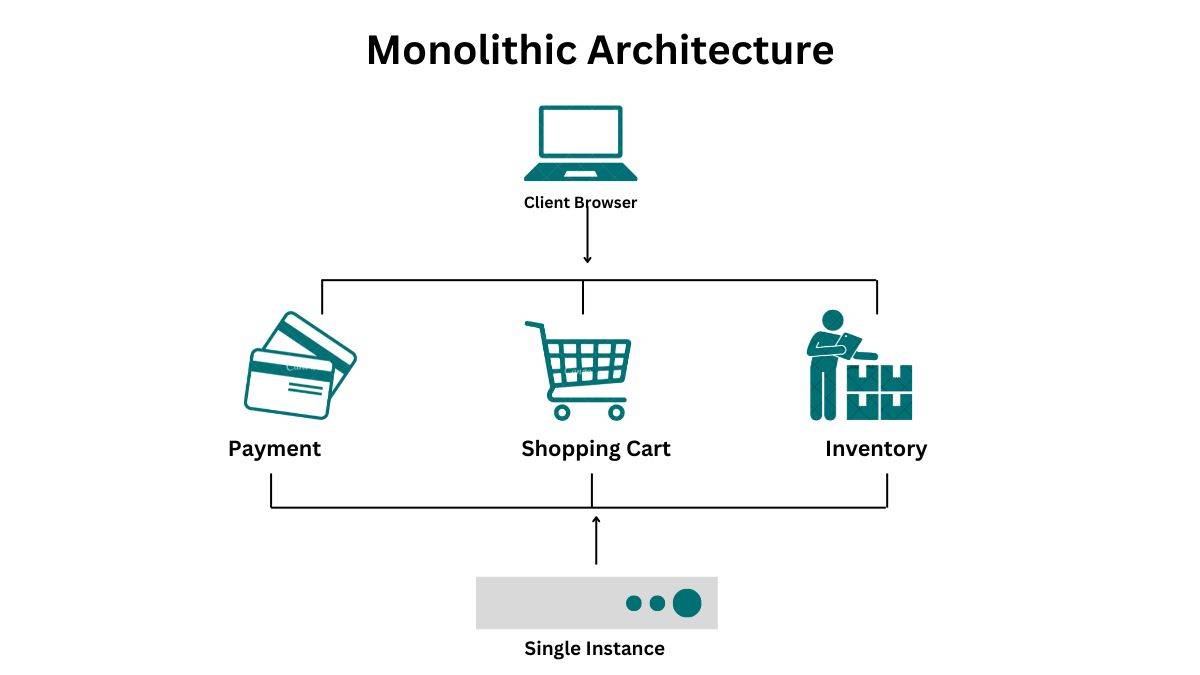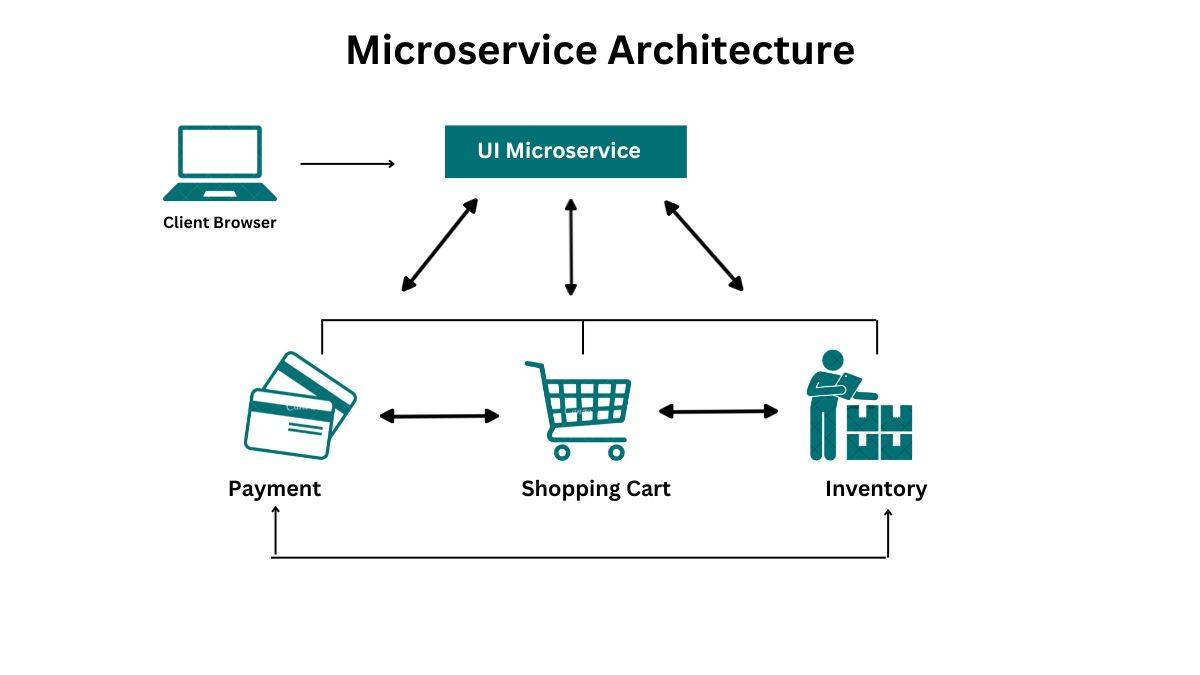Monolithic vs Microservices Architecture
Monolithic applications are built as single unified unit whereas microservices architectures are the collection of smaller yet independently deployable services. With time, microservices have taken the load and replaced monolithic components on many levels.
In this article on Monolithic vs Microservices, we will discuss these two architectures in detail. We will also discuss how the two differ in terms of features and purposes.
Table of Contents
Monolithic vs Microservices Architecture: Differences
Monolithic and microservices are differentiated based on the following parameters:
| Parameter | Monolithic architecture | Microservices architecture |
| Foundation | Built as one large system and is one code-base | Built as a small and independent module based on the business functionality |
| Fault Tolerance | Low | High |
| Scalability | Not easy to scale | Easy to scale |
| Complexity | Less | More |
| Database | Shared database | Own database |
| Built Time | Build time is increased | Built time gets decreased |
| Changes in Technology | Extremely difficult since everything is tightly coupled and dependent on each other | Easy to change since each module and project is independent |
Best-suited IT & Software courses for you
Learn IT & Software with these high-rated online courses
What is Monolithic architecture?
A monolithic architecture is a traditional model of software programs. It is built as a unified unit that is self-contained and independent from other applications. Monolithic architecture is a singular and large computing network that has one code based to couple all business concerns together.
Advantages of Monolithic Architecture
A Monolithic architecture has the following advantages:
- Monoliths are convenient to use in the beginning of any project since they allow easy code management, cognitive overhead and deployment. Due to this advantage, everything in monolith architecture can be released at once.
- The monolithic approach is a standard method to build applications that require no additional knowledge. The source code is located at one place which makes it easier to understand.
- Since monolithic applications are single and centralized units, end-to-end testing is faster than with distributed applications.
- It is easier to debug and follow the flow of requests since every code is located in one place.
- Cross-cutting is required only once and customizations are also only used once.
- There is no limitation from the business logic perspective.
- It is simpler to scale horizontally by running multiple copies behind load balancer.
Limitations of Monolithic architecture
A monolithic architecture does have certain limitations as mentioned below:
- Since all services are located in one place, any changes may require rebase and wait.
- Teams can affect each other since there are no boundaries between responsibility towards services.
- Regression for complete monolithic service is required since even a small change can negatively impact the system.
- There is an additional cost for application operability as in case of performance issues; you will have to scale the entire monolithic service.
- The minutest changes require the redeployment of the entire monolith.
What is Microservices Architecture?
Microservices or Microservices architecture is an architectural method that relies on independently deployable services. These services come with their own business logic and database having a specific goal. This architecture decouples major business and domain-specific concerns into separate and on the basis of independent code.
Explore database courses
Advantages of Microservices Architecture
A microservices architecture has the following advantages:
- Microservices are extremely helpful for software and companies that are in the expansion phase.
- A microservices architecture contains units that run independently due to which every service can be independently developed, updated, deployed and scaled. Other units remain unaffected.
- More frequent software updates can be performed with improved uptime, reliability and performance.
- Teams can easily experiment, update and even roll back code if something goes wrong.
- Microservices accelerate release cycles with continuous integration and continuous delivery (CI/CD).
- Once a microservice reaches its load capacity, the new instances of the service can be rapidly deployed to the accompanying cluster to relieve pressure.
- Since microservices are individual units, independent, fast and easy deployment of individual features is possible.
- They are simple and efficient due to which they are cost-efficient. They help in improving efficiency and thus fewer errors.
- Microservices are self-contained which requires less coordination and communication.
Limitations of Microservices
The following points indicate the limitations of most microservices architecture:
- These have higher complexity due to which it becomes difficult to deal with for those organizations that have no prior experience with microservices.
- Since microservices are independent units, it is very difficult to track down the errors and resolve them.
- Microservices are self-contained which can make them dependent on networks for communication with each other. This can lead to network latency and an increase in the network traffic.
- Since they are deployed independently, it takes longer to get them together and running. For a proper coordination, developers must be aware of multiple technologies while working on the microservice-based applications.
- Microservices were introduced to resolve the issue with the use of Monoliths. However, microservices have a lot of machine requirements. Due to this requirement, containers were introduced that required Kubernetes.
Explore free Kubernetes courses
Explore technology courses
Monolithic vs Microservices: Which one is better?
On the basis of the following comparisons, you can decide the once that suits your requirements:
- Microservices are efficient in comparison to monolithic applications.
- A microservices architecture is self-contained due to which it needs lesser coordination and communication than monolithic applications.
- It is easier to update microservices due to their small size rather than a monolithic application.
- The product can be brought faster to the market using microservices instead of monoliths.
- Microservices have more fault tolerance than monolithic applications.
- Monolithic applications are less complex than microservices.
- It takes less time to develop monolithic applications than microservices.
FAQs
Can you migrate from a Monolithic to a Microservices Architecture?
Yes, it is possible to migrate from a monolithic to a microservices architecture. This process involves identifying and decoupling components of the monolithic application into individual microservices. The migration should be done incrementally to ensure stability and minimize risk.
What are the differences between Monolithic and Microservices Architectures?
- Scalability: Monolithic applications are typically scaled vertically, adding more resources to a single server. Microservices can be scaled horizontally, distributing the load across multiple servers.
- Development: In a monolithic architecture, a single development team works on a unified codebase. Microservices allows multiple teams to work independently on different services.
- Deployment: Deploying a monolithic application often requires the entire system to be rebuilt and redeployed. Microservices allow for continuous deployment and individual updates without affecting the whole system.
- Complexity: Monolithic architectures are simpler to develop initially but can become complex to manage as the application grows. Microservices introduce complexity in terms of service orchestration and inter-service communication but offer better long-term manageability.
What are the best practices for deploying Microservices?
- Containerization: Use containers (e.g., Docker) to package microservices for consistent deployment across different environments.
- Orchestration: Use container orchestration tools (e.g., Kubernetes) to manage deployment, scaling, and operation of containers.
- CI/CD Pipelines: It is important to implement continuous integration and continuous deployment pipelines to automate the build, test, and deployment process.
What are the drawbacks of microservices architecture?
- Complexity: Increased complexity in managing multiple services, dependencies, and communication.
- Latency: Network latency can be introduced due to inter-service communication.
- Data Management: Challenges in ensuring data consistency and managing distributed data.
- Operational Overhead: Increased need for sophisticated monitoring, logging, and orchestration tools.








